If you’re a cat parent, you understand the phrase “Curiosity kills the cat”. If you are a cat parent who also loves plants, you understand it a little better. Many cat owners love having plants in their homes but can’t seem to keep their cats away from the greenery.
Cats are naturally curious and may be attracted to plants for various reasons, such as smell, taste, appearance, or shade.
- Some houseplants are toxic to cats causing health issues.
- Cat deterrents like double-sided tape can keep cats away from plants.
- Mesh or wire barriers act as physical plant cages to deter cats.
- Cat-repellent sprays with natural oils can protect plants from cats.
- Consistent behavior correction can train cats to leave plants alone.
Unfortunately, this can be harmful to both the plants and the cats. Some plants may be toxic or cause digestive issues for cats, while cats may damage or destroy the plants by chewing, scratching, or digging.
The information provided herein is for informational purposes only. Please refer to our disclaimer for more details..
Why is your cat fascinated with indoor plants?
Cats are fascinated by indoor plants because of their curiosity, scent attraction, and even their hunting instincts. Cats are curious animals that have learned to explore their surroundings by scent, taste, and touch.
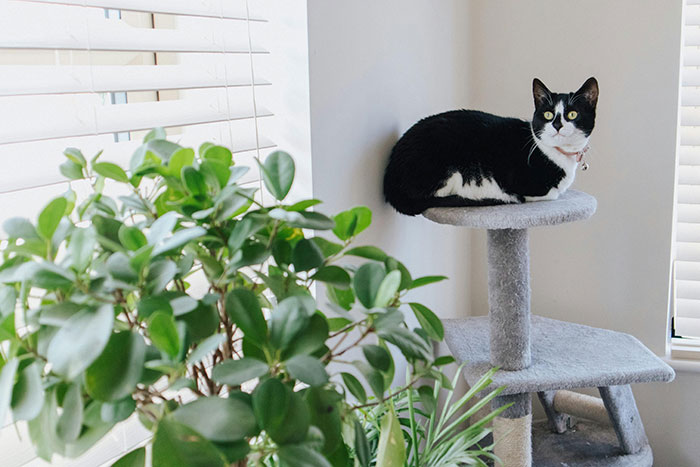
Image credit: Anete Lusina
Unfortunately for us, our house plants usually stimulate all three senses. This makes cats and plants good pals and usually leads to them pooping in or eating plants.
Why should you keep your cats from eating houseplants?
While plants beautify our houses, they can cause toxicity and allergic reactions and even be a choking hazard for cats. In addition to this, consumed plants may cause gastrointestinal issues in pets and lead to vomiting, diarrhea, and abdominal pain.
Unfortunately, some plants are toxic to cats. When consumed, toxic houseplants like peace lilies, aloe vera, English ivy, and many more can cause severe damage to cats. These plants have various chemical compounds like alkaloids and saponins that, when ingested, can harm a cat’s health.
According to Too Plants, toxicity can also occur when cats eat the plant soil, touch leaves, or even have skin contact with sap. Hence, keeping our cats from getting to toxic plants is best.
Ways to keep cats away from plants
To ensure the safety and health of your fluffy companion, here are 10 proven ways to keep your cats away from plants.
Use a cat deterrent
Although cats are naturally inquisitive, they tactfully remove themselves from objects or spaces they find even mildly unpleasant. You can often keep them away from plants by using deterrents like double-sided tape or aluminum on the base of these plants.
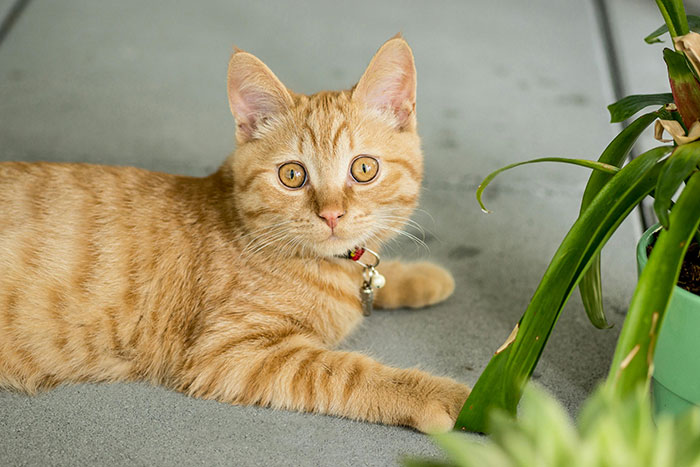
Image credit: Matheus Guimarães
Place double-sided tape around the base of your houseplants. Your cat’s paw pads have specialized nerves that make them extremely sensitive to various textures and sensations.
Cats do not like the sticky texture of tape on their paws and this unpleasant sensation ultimately leads to your cat keeping away from your plants.
You could also surround your houseplant with aluminum foil or plastic wrap. Cats dislike aluminum foil’s texture and sound and prefer to stay away.
Use plant cages
Make your plants inaccessible to your cats by setting up a mesh or wire barrier around the plant. Remember that cats are agile climbers, so the barrier should be tall enough to deter your cat from reaching the plant.
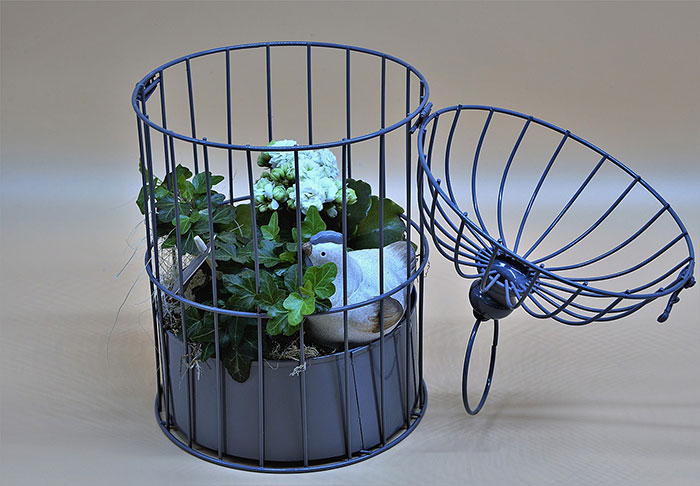
Image credit: HOerwin56
Invest in decorative cages or screens specifically designed to keep cats away from plants. This is a good cat deterrent as it communicates to your cat that specific areas are out-of-bounds.
It also creates a psychological effect. The physical presence of the fencing or screen around a plant creates a psychological barrier for your cat and discourages it from attempting to jump over it.
Use cat-repellent sprays
Cat-repellent sprays are one of the most common methods of keeping your plant safe. These sprays usually have strong odors or flavors that cats find offensive. Typical ingredients for these sprays include citrus extracts, bitter agents, and natural oils.
Examples of homemade cat repellent sprays include bitter lemon spray, vinegar and water spray, peppermint oil spray, and lavender spray. Cats dislike the smell of these sprays and will stay away from sprayed plants. There are also artificial spray repellents for cats.
Place your plants out of reach
Additionally, you can place your plants out of reach by hanging your plants on windowsills. Hanging plants helps deter your cat visually, signaling that your household plants are off-limits. Your cat isn’t oblivious, a clear physical boundary can help establish a boundary in its mind.
Try using motion-activated misters
Motion-activated misters repel cats from plants by spraying a water mist when they detect movement near them. It simply startles the cat without causing any pain or lasting discomfort and helps correct cat behavior like eating or urinating in plants.
Cover the surface of the soil
To stop cats from pooping in potted plants, cover the soil with a plant saucer. Some plant owners have also recorded success by filling the pot with materials that make it difficult for cats to dig, like stone mulch.
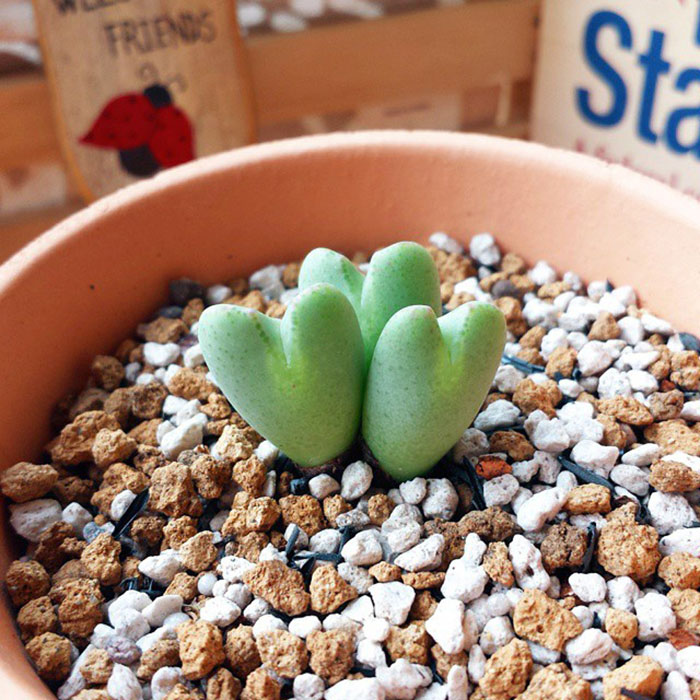
Image credit: bittersugarxoxoxo
Place rocks or decorative stones around the base of your plants. If your cat likes digging up your potted plants or garden plants, then it may be deterred by the uneven surface the rocks create. As agile creatures, they prefer surfaces that provide good traction.
Keep plants that deter cats
According to Sloane and Sons, cat-repellent plants like lavender, the scaredy cat plant, and rue can keep cats from using your garden as their litter box. These plants usually emit pungent odors or have textures that cats hate and are sure to keep your cat from getting near your plants.
Give your cat some cat grass
Encouraging your cat to eat cat grass can serve as a natural way to deter them from nibbling on other plants in your home. By providing an appealing alternative, you can redirect your cat’s attention away from harmful or decorative plants.
Cat grass is often grown from seeds of cereal grasses like barley, wheat, or oats. It is safe for cats and provides a natural way for your cat to satisfy their instinctual need to chew on greens. Cat grass can also aid digestion, remove fur from the stomach, and supply vitamins and minerals.
Consistently correct the behavior
Your cat thrives on routine and predictability. A consistent reward and correction routine helps it understand what is expected of i.
Consistently redirect your cat’s attention to an appropriate one if it engages in undesirable behavior. Your feline friend may simply be playing with your plants out of boredom.
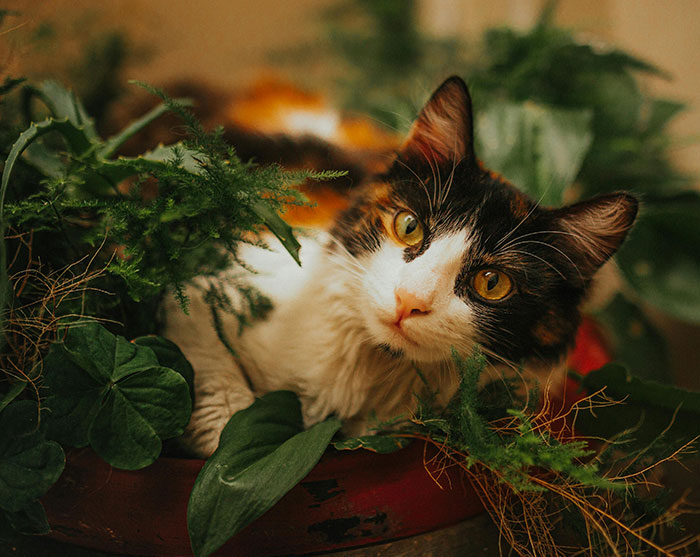
Image credit: Toni Ferreira
When you notice your cat around your plant, engage it with toys or interactive play to divert their attention away from the plants. You may also gently guide it towards cat grass or buy a large cat tree to get them busy there.
Also, give consistent responses to the same behavior every time. This reinforces the message. Saying a stern “No” every time your cat enters the garden space will eventually teach it that you don’t like that behavior.
Keep a close eye on your cat
When your cat is outdoors, regular supervision is essential. Whether in your garden or another outdoor space, keep a watchful eye on your cat and intervene quickly if they show interest in plants that could be harmful.
Tips for training your cat to leave plants alone
Just like you, your cat is a creature of habit, and it tends to repeat behaviors with positive rewards. Cats can be trained to leave your plants alone by creating a reward system. Here’s how to do it;
- Choose rewards your cat finds motivating. Cats love treats, praise, and playtime. Just make sure your cat enjoys the rewards you pick.
- Reward immediately. Whenever you can redirect your cat from playing with plants by engaging in alternative activities, give a prompt reward. This helps create a positive association with good behavior.
- Engage in clicker training. This involves using a small device that makes a distinct clicking sound. Click when your cat displays the desired behavior, followed by a reward. The click serves as a marker for the correct behavior.
- Associate words or cues with the desired behavior. Specific words like “good” or phrases like “nice job” will help your cat associate the words with positive outcomes.
Frequently asked questions
What are natural cat repellents?
Natural cat repellents such as citrus scents, aluminum foil, and certain plant types like citronella and lavender can effectively keep cats away from plants. These scents are known to deter cats while being safe for them.
Why is your cat digging up plants?
Cats may dig up plants for a variety of reasons. It could be an attempt to create a comfortable resting spot, or they may simply explore their surroundings and engage in natural behaviors.
Why do cats use plants as a litter box?
Cats may use potted plants as a litter box due to their natural inclination to dig and bury their waste. This behavior can be frustrating for cat owners but can be managed with the right strategies.
1Kviews
Share on FacebookJust use plants they can eat, then both cats and humans can enjoy them 👍 https://www.aspca.org/pet-care/animal-poison-control/cats-plant-list
Load More Replies...Just use plants they can eat, then both cats and humans can enjoy them 👍 https://www.aspca.org/pet-care/animal-poison-control/cats-plant-list
Load More Replies...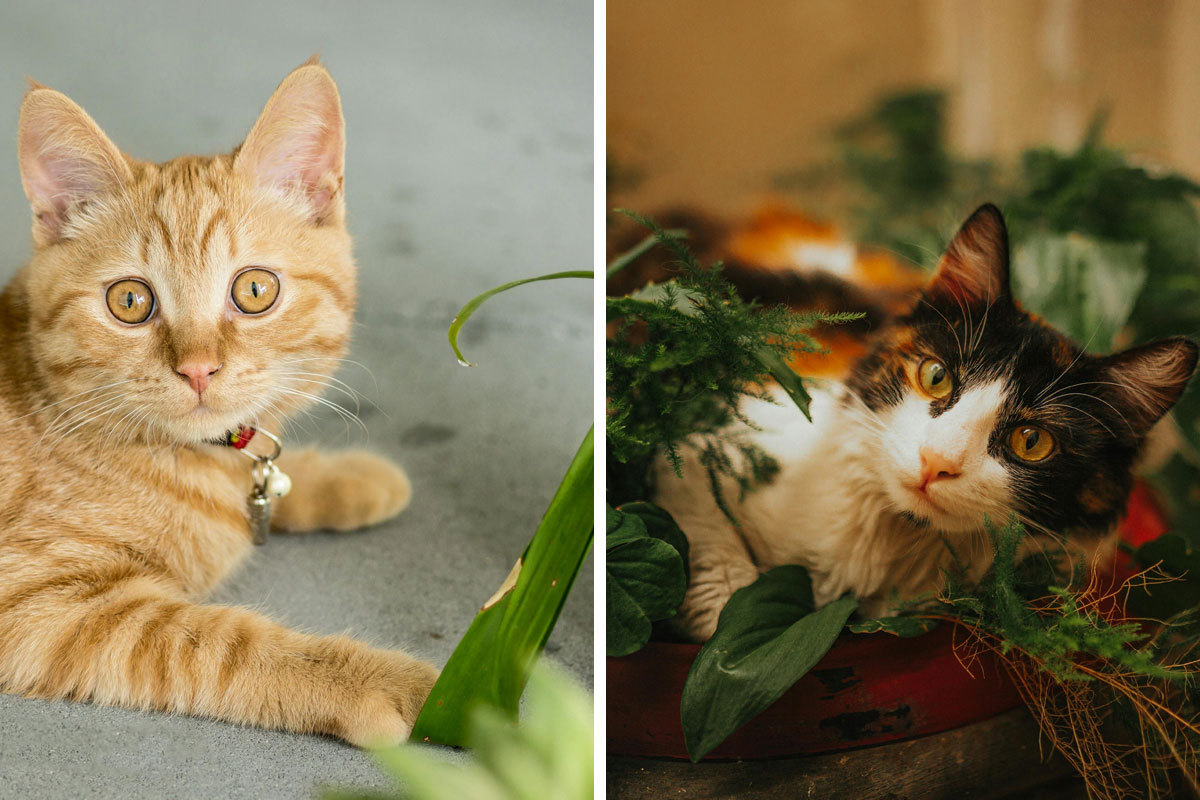



10
2